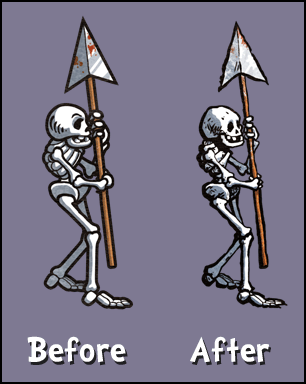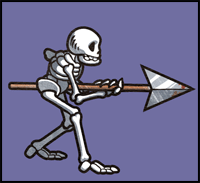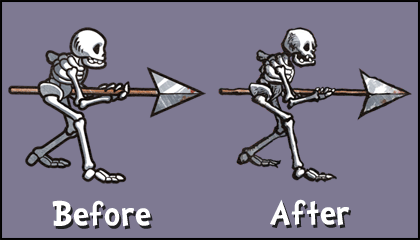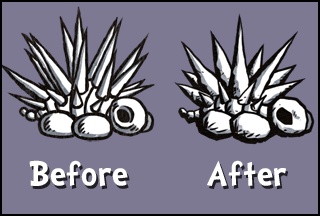
In this week’s Pizza Vs. Skeletons update, I want to talk about what I consider to be one of the most challenging aspects of game development: Knowing when “good” is “good enough,” and when “good” needs to be made “better.”
Last week, I posted about a new animation process I’m using for Pizza Vs. Skeletons, and I showed off an example animation.

When I made this animation, I considered it to be solid, and certainly passable for a cartoony iOS game. However, as the week went on, I couldn’t get rid of the feeling that I’d taken the 3D rotoscoping process too literally. Instead of using the 3D version as a rough motion guide, I traced it pixel-for-pixel. The result was a nice, clean, animation. Unfortunately though, Pizza Vs. Skeletons’ artwork is supposed to be everything but nice and clean. The animation just didn’t have the character to match the rest of the game’s art.
I faced a tough question: Do I let the art pass and call it “good enough,” or should I redo hours and hours of work in pursuit of an even better style?
Answering questions like these is not simply a matter of style or personal taste. These are significant business decisions. They are so important, in fact, that I would argue that the way a studio approaches the decision of when to redo work defines it as a company.
The Perfectionist Approach
On one end of the spectrum are companies like Nintendo and Blizzard. It is clear from their games’ extraordinarily long development cycles, impeccable polish, and near universal acclaim, that these companies almost always choose to “make it better” when given the opportunity. Just look at the list of games that made the Smithsonian Art of Games exhibition. Is it an accident that so many of the games were published and developed by Nintendo? Absolutely not. They will delay a game without mercy in their quest to make something extraordinary.
As compelling as it may seem to choose the path of the perfectionist, it is not the only valid business approach, and not the only strategy for producing memorable games.
Both Blizzard and Nintendo came of age when the game industry was driven by brick-and-mortar retail. Compared to today, relatively few games were released each year. If a big publisher made a near-perfect game, it was usually able to bask in its success for a long time.
As tired as it sounds to say it, online distribution and mobile platforms have changed everything. I’d venture to guess that as many iOS games are released in a week as there were NES games in a year. Marketing has also transformed. In the 90s, if you wanted a game to sell, you made lots of TV and print ads. As long as the game had at least moderately broad appeal, it would probably sell well.
Conversely, marketing success today is not as straightforward. On iOS, for example, the most significant determinant of a game’s launch success is how prominently Apple chooses to feature it in the App Store. The process by which Apple chooses to feature games is, as far as I know, completely opaque to developers. It might as well be left up to chance. (Note that I’m not complaining about this. I trust Apple to choose quality products more than I trust community consensus, and their black-box process prevents the system from being gamed.) There are also “offer walls,” “free-to-play” apps, and myriad other marketing contraptions that may or may not make a game a sales success.
The Lottery Approach
Extraordinarily abundant competition and market unpredictability have given rise to an alternative business model I call the “lottery approach.” The essential idea is that a developer creates as many titles as quickly as possible while maintaining some baseline level of quality. The titles should be fun and polished, but perfection is not a necessity.
The justification is simple: These days, a handful of decent mobile games is much more likely to score a hit than a single “Triple A” game. Let’s say, for example, that a company can make a really great game in a year, or that they could make six merely good games in the same period of time. For the sake of argument, let’s say that the good games each have a 10% chance of being a big hit on the App Store, and that the great game has a 20% shot, since it is so much better.
Given these odds, the developer should clearly choose to make the six good games, because cumulatively there is an almost 50% chance of one of them being a hit. The 10% and 20% numbers are fabricated of course, but it should be nonetheless clear that a handful games with decent odds is preferable to a releasing single great game, even if its odds of success
are significantly better than any individual “good” game.
(Note: It is important to reiterate here that I’m comparing good games with really good games. The majority of games on the App Store are so mediocre that their odds of success are virtually zero and not really worth discussing.)
Effect on Players
One might assume that there would be a negative effect on players if all developers started releasing droves of “B” grade titles rather than focusing on “AAA” games. However, this is only partially true.
A funny thing happens when a B-grade game becomes successful: In players’ minds, it becomes an A-grade game. Maybe not “AAA,” but great nonetheless. Angry Birds is the classic example of this. No offense to my friends at Chillingo or Rovio, but I truly doubt they knew what they had on their hands when Angry Birds was released. They probably thought they had a solid B-grade game. With Chillingo releasing so many decent titles, odds were in their favor, and Angry Birds struck gold, transforming it into an A-list game.
And what about all the B-grade games that aren’t successful? Don’t they just clog up the market? No. People just don’t play them.
Choosing between Good and Great
So which path should a company choose? How much of a perfectionist should a developer be? How many delays are acceptable in the pursuit of quality? How many eggs should be put in how many baskets?
As I claimed earlier, this is the decision that defines a company and its games. Both approaches can lead to success. However, if I were to advise a company just starting out, I would probably suggest the lottery approach. The reason for this is that early on, one’s development senses aren’t usually refined enough to even tell the difference between good and great in one’s own work. Therefore it makes good sense to get a lot of titles under your belt while you learn the craft. On the other hand, if you have more than, say, 100 million dollars in your bank account, it’s probably worth it to risk producing a masterpiece.
What about Pizza Vs. Skeletons?
As for the animations in Pizza Vs. Skeletons, I decided to change them. I scrapped every frame of animation in the entire game. I can’t say for sure that this was a good business decision. Maybe nobody but me will really notice.
In the end though, you have to set aside logic and go with your instincts. And mine said, “Make it better.”






